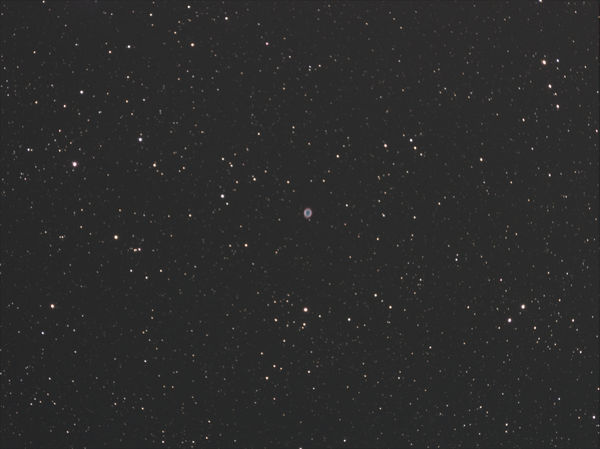Infrared, anybody?
May 1, 2019 17:19:32 #
It's infrared season in North America, and looking around I found little enthusiast discussion, so I thought it might be good to start one.
I've been shooting with a Kolari-converted 720nm Fuji X-E2. Oddly, I've not found the Fuji lens that handles IR well. Most produce hotspots or, at least, a central color shift similar to vignetting and a real pain to repair. Even more oddly, I've found that my old manual-focus Nikkors, with an adapter of course, seem to work just fine in infrared. There's a good chance that in the coming weeks I'll have my original X100 converted to 590nm and dedicate the X-E1 to black-and-white, which is to me purer infrared anyway.
I shoot JPEGS, most of them in color, and bring them in to the GIMP 2.10.10 for auto white balance, channel swap, hue and level adjustment and -- a wonderful addition to GIMP 2.10.x -- toning down highlights and pulling details out of the mud with its new sliders. Here's one I shot and processed a few minutes ago that I like.
Anybody else shooting infrared in the spring? Any special techniques? Any treatment for hotspot issues?
I've been shooting with a Kolari-converted 720nm Fuji X-E2. Oddly, I've not found the Fuji lens that handles IR well. Most produce hotspots or, at least, a central color shift similar to vignetting and a real pain to repair. Even more oddly, I've found that my old manual-focus Nikkors, with an adapter of course, seem to work just fine in infrared. There's a good chance that in the coming weeks I'll have my original X100 converted to 590nm and dedicate the X-E1 to black-and-white, which is to me purer infrared anyway.
I shoot JPEGS, most of them in color, and bring them in to the GIMP 2.10.10 for auto white balance, channel swap, hue and level adjustment and -- a wonderful addition to GIMP 2.10.x -- toning down highlights and pulling details out of the mud with its new sliders. Here's one I shot and processed a few minutes ago that I like.
Anybody else shooting infrared in the spring? Any special techniques? Any treatment for hotspot issues?
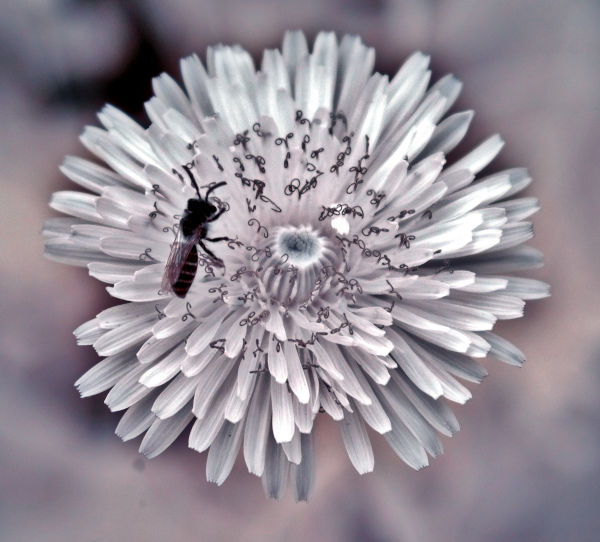
May 1, 2019 17:49:45 #
Many years ago, pre digital, often I'd carry two cameras. A Canon A1 with regular Ektachrome and an AE-1P with Ektachrome EIR. I was fascinated by the difference in the colors between infrared and normal light.
I haven't played with infrared for probably over 40 years now but I'm sure I still have boxes packed away containing boxes of slides from back then. It was a lot of fun...
I haven't played with infrared for probably over 40 years now but I'm sure I still have boxes packed away containing boxes of slides from back then. It was a lot of fun...
May 1, 2019 17:54:55 #
depscribe wrote:
It's infrared season in North America, and looking... (show quote)
I used to shoot a lot of B&W infrared film in 35mm and 4x5. I never like the color IR film because it was just too far out, with the red skies and all. When I went digital, I saw some IR from converted cameras which had blue skies, and I learned it was a red-blue channel swap which did that. I got an old Nikon D70s converted by Lifepixel with their enhanced color filter, because I knew I wanted to experiment with faux color IR. I found a Photoshop action on the internet which did the channel swap, as well as other adjustment layers which can be tweaked. It's available now at https://khromagery.com/2011/07/04/false-colour-infrared-photoshop-action-on-photoshop-exchange/
After the channel swap, I experimented with saturation of the overall image, and saturation of individual colors to bring out many and varied colors not obvious in the out of camera image. I also played with flash fill, which gives different colors in IR than sunlight. Here are some samples - the last three have flash fill.
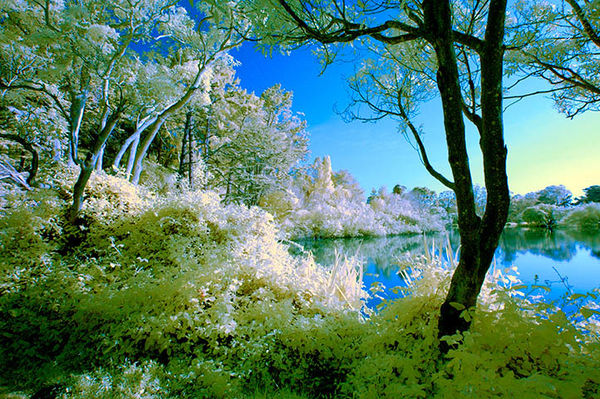
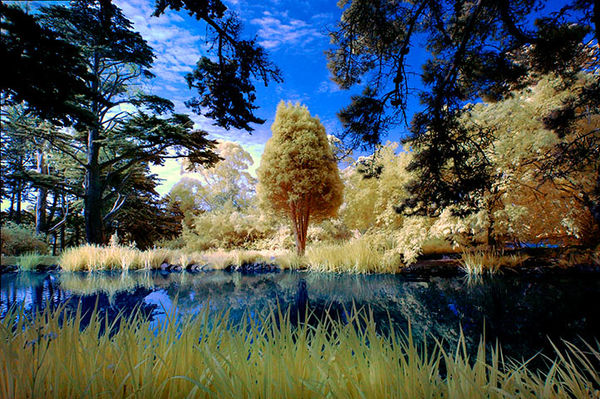
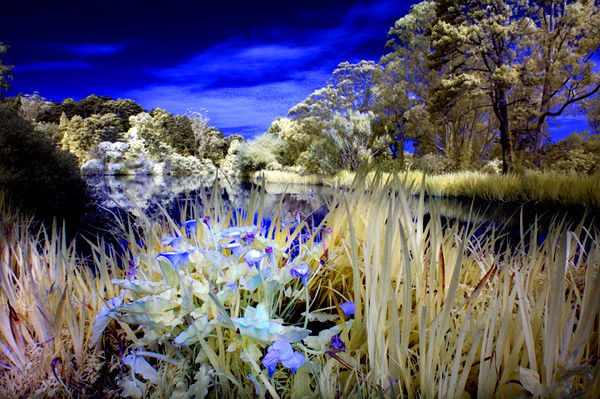
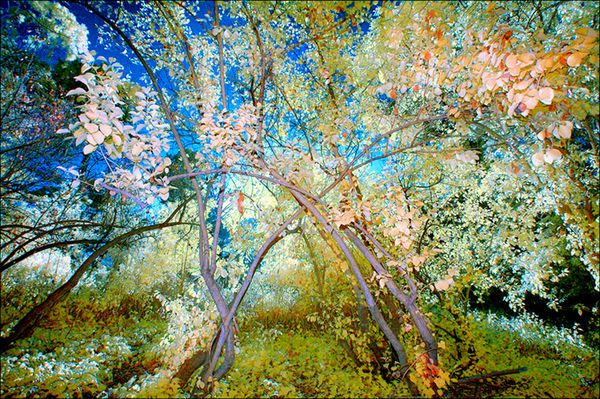
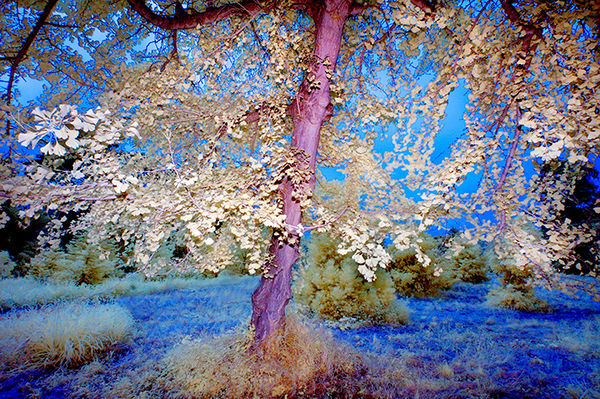
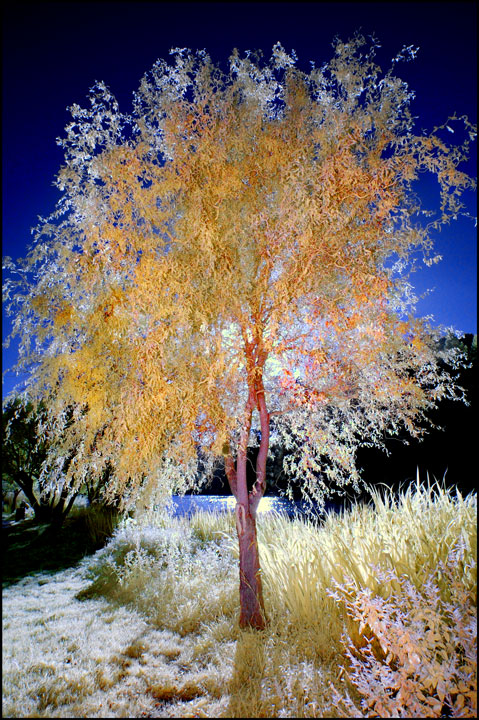
May 1, 2019 18:13:46 #
May 1, 2019 18:16:13 #
Infrared Ektachrome was a hoot. I typically shot it in of all things an Olympus Pen F -- because I had a red filter of the right size for its lenses (and because I'd get twice as many pictures, though mounting half-frame cost extra). I'd often forget that visible light focus and infrared focus were different, so I got a lot of unsharp pictures, such as the attached from 1970, which I kept because it messed around with *every* color.
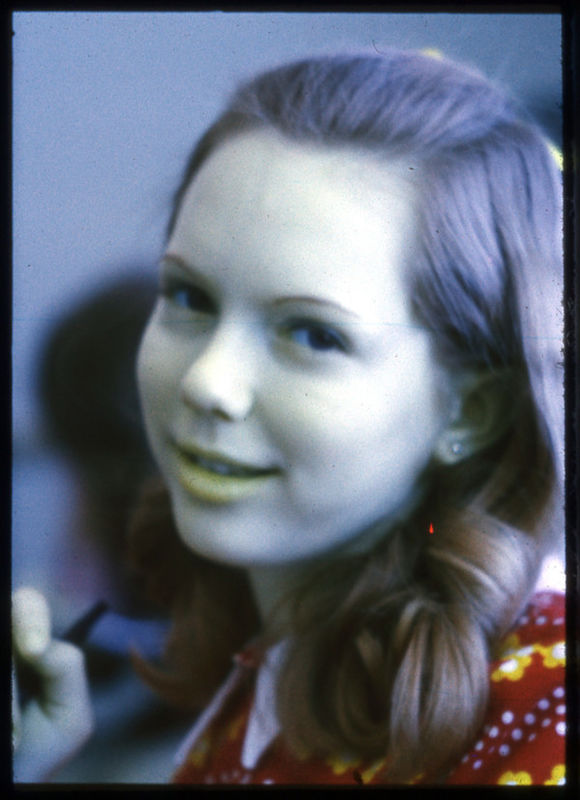
May 1, 2019 18:25:33 #
Nice work! Some of it looks similar to the "Color Enhance" function in GIMP, though that's a roll of the dice (which can be dialed back in further processing, but still.
The flash fill is interesting. I have a little LED bank in IR, but it produces straight 850nm light, so no color. ($30 on eBay or Amazon or someplace.) And a couple of the pictures have that cool gold 590nm look to them. Fun stuff.
Here's a picture from Monday taken with the Rokinon 12mm f2 on the Fuji -- and it has a vague but really irritating hottish spot toward the center. I was able to dial it back by desaturation, so it's usable, but it would be a better picture if it were uniformly exposed. (Which I'm hoping I can get from the X100, which I'll convert only if I'm fairly sure it will be happy there.) It is OOC with auto white balance, channel swap, and a little hue/saturation fiddling.
The flash fill is interesting. I have a little LED bank in IR, but it produces straight 850nm light, so no color. ($30 on eBay or Amazon or someplace.) And a couple of the pictures have that cool gold 590nm look to them. Fun stuff.
Here's a picture from Monday taken with the Rokinon 12mm f2 on the Fuji -- and it has a vague but really irritating hottish spot toward the center. I was able to dial it back by desaturation, so it's usable, but it would be a better picture if it were uniformly exposed. (Which I'm hoping I can get from the X100, which I'll convert only if I'm fairly sure it will be happy there.) It is OOC with auto white balance, channel swap, and a little hue/saturation fiddling.
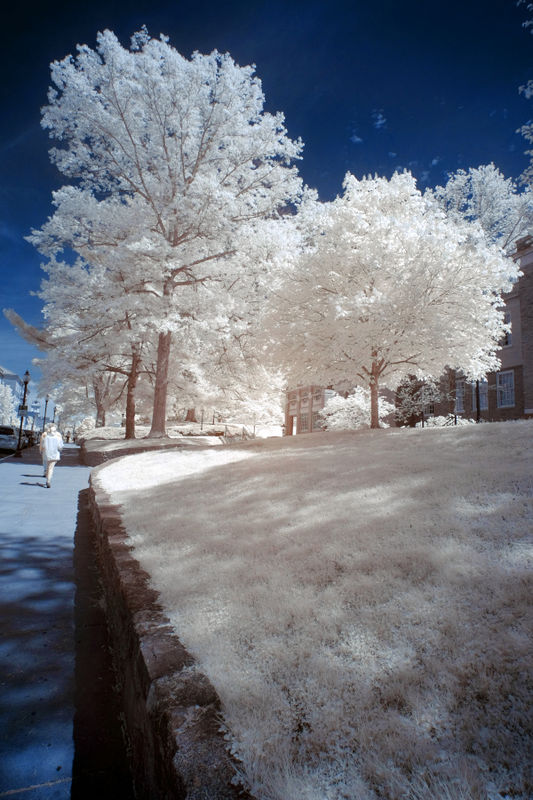
May 1, 2019 18:54:43 #
Cany143
Loc: SE Utah
I don't mean to take away from your post, depscribe, but......... John! Those are some stunning images! Numbers 4 and 5 in particular have a really, really tactile quality. To the point, perhaps, that if either were printed, and you ran your hand across them, in some places you'd feel raised bumps, and in other places your skin would get ripped. I'm seriously impressed!
May 1, 2019 18:58:21 #
depscribe wrote:
It's infrared season in North America, and looking... (show quote)
I have two cameras modified to full spectrum. A Sony A55 and an Olympus EM5ii. Regarding hot spots, I find that the farther I stop down, the worse that a hot spot becomes. But I only have one lens that exhibits a hot spot, that I have discovered so far. And that is an 18-55mm Sony kit lens. And even with that lens, only when I stop down too far.
Just for fun, to show that IR can be used for other purposes, here is a shot I did using a 715mm f7 telescope with the Olympus EM5ii modified as full spectrum. And FYI, shooting using filters such as 720nm, light pollution is less of a problem. As for this one, I used no filter, and I had done a white balance during the day with an 18% gray card. As you can see, this one was able to pick up the Ring Nebula with ease. The EM5ii 2x crop factor made this one seem like a 1430mm focal length.
May 1, 2019 20:09:17 #
Cany143 wrote:
I don't mean to take away from your post, depscribe, but......... John! Those are some stunning images! Numbers 4 and 5 in particular have a really, really tactile quality. To the point, perhaps, that if either were printed, and you ran your hand across them, in some places you'd feel raised bumps, and in other places your skin would get ripped. I'm seriously impressed!
Thank you. I've never been an adherent of the idea that the best purpose of photography is to be as realistic as possible, so the faux color IR is perfect for me. It's the flash fall-off that gives the kind of 3D effect in the two you mentioned. I have gotten criticism that they are too saturated, but I think they look better printed than onscreen. I have printed them 11.3 x 17 on 13 x 19 paper, and they look surprisingly good considering it's only a 6 megapixel camera. I just had an old studio workhorse Nikon D2X converted to IR so I'll have a big 12 megapixels now.
May 1, 2019 20:23:43 #
May 1, 2019 20:25:53 #
JimH123 wrote:
I have two cameras modified to full spectrum. . . .
I've been curious about the full-spectrum stuff. Do you usually use a UV filter? Have you done any UV-pass stuff?
May 1, 2019 20:46:48 #
depscribe wrote:
How do you deal with the IR focus shift when using an SLR?
I deal with it by shooting with a wide angle (Nikon 12-24 on a crop sensor, almost always at 12) and using an aperture of at least f8. Then I just use autofocus, and the focus is always fine.
May 1, 2019 21:04:55 #
depscribe wrote:
How do you deal with the IR focus shift when using an SLR?
With the Sony A55, I use manual focus only. It is so easy to manually focus with this camera. Since it is a SLT type camera, it uses a translucent mirror to deflect some of the image up to a secondary sensor, sort of like a DSLR does it, and that path is subject to focus shift. But manual focus is not affected. And yes, if I autofocus, I can definitely see that the image is out of focus.
The Olympus EM5ii is a mirrorless, and focus is done at the sensor, It does perfect AF no matter what auto focus type lens that I use and there is no need to be concerned about the IR shift.
May 1, 2019 21:06:30 #
depscribe wrote:
I've been curious about the full-spectrum stuff. Do you usually use a UV filter? Have you done any UV-pass stuff?
I don't bother with anything regarding UV, No matter what IR type filter I use, the UV light is way out of the bandpass of the filter and is no problem.
May 1, 2019 21:50:17 #
JimH123 wrote:
I don't bother with anything regarding UV, No matter what IR type filter I use, the UV light is way out of the bandpass of the filter and is no problem.
What does full spectrum bring as opposed to, say, a 590nm IR conversion? With the X-E2 I have 720nm natively after conversion, and throw an 850 or 950nm filter on for black and white (because of the conversion I can see through the 950, which I wouldn't be able to do, and autofocus would be impossible). What happens if you shoot your full-spectrum camera with no filter?
If you want to reply, then register here. Registration is free and your account is created instantly, so you can post right away.



